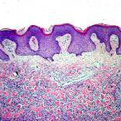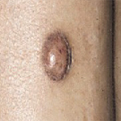Dermatofibroma
General Information
Dermatofibroma is an extremely common firm bump on the skin, representing an overgrowth of the tissue lying between the outer and inner layers of skin. Typically, small (0.5- to 1-cm) red-to-brown, darker depending on the individual’s skin color, bumps (nodules). Dermatofibromas are most commonly seen on the extremities, particularly the lower legs. Although the cause is unknown, DF is often linked to some traumatic insult to the skin (eg, insect bite). Dermatofibromas generally cause no symptoms, except for the occasional itching. The nodules are usually not treated, unless they become bothersome or enlarged. A healthcare provider can remove them with a scalpel
Epidemiology
Relatively common, but are seen more in adults, particularly females.
Etiology
Unknown, linked to trauma, insect bite, cuts
Pathogenesis
Accumulation of collagen, which is a protein made by the cells (fibroblasts) populate the soft tissue under the skin
Clinical
Typically, a solitary 0.5- to 1-cm nodule.
Histology
Overlying epidermis is usually acanthotic. Pseudoepitheliomatous hyperplasia and a basaloid proliferation may be noted.
Bibliography
1. “Dermatofibromas” (Online) February 2003. http://www.merck.com/mmhe/sec18/ch215/ch215e.html (visited: March 16, 2008) 2. “Dermatofibromas” (Online). January 2007. http://www.emedicine.com/DERM/topic96.htm (visited: March 16, 2008)
Download PDF
![]() Dermatofibroma
Dermatofibroma


